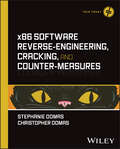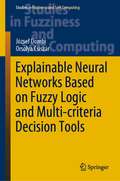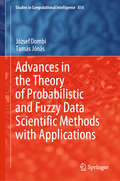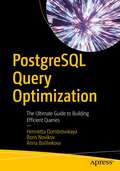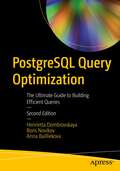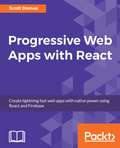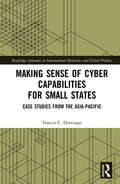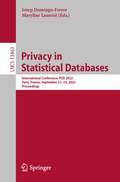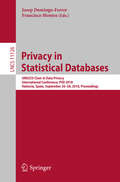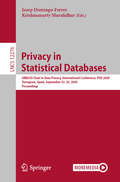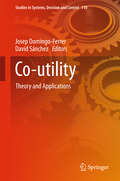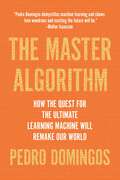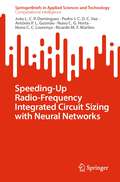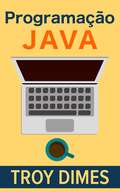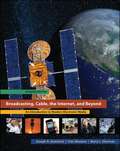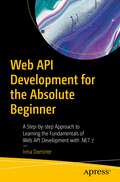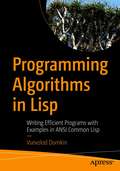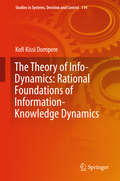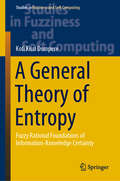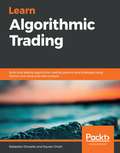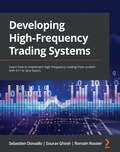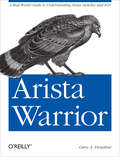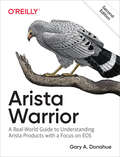- Table View
- List View
x86 Software Reverse-Engineering, Cracking, and Counter-Measures (Tech Today)
by Stephanie Domas Christopher DomasA crystal-clear and practical blueprint to software disassembly x86 Software Reverse-Engineering, Cracking, and Counter-Measures is centered around the world of disassembling software. It will start with the basics of the x86 assembly language, and progress to how that knowledge empowers you to reverse-engineer and circumvent software protections. No knowledge of assembly, reverse engineering, or software cracking is required. The book begins with a bootcamp on x86, learning how to read, write, and build in the assembly that powers a massive amount of the world’s computers. Then the book will shift to reverse engineering applications using a handful of industry favorites such as IDA, Ghidra, Olly, and more. Next, we move to cracking with techniques such as patching and key generation, all harnessing the power of assembly and reverse engineering. Lastly, we’ll examine cracking from a defensive perspective. Providing learners with techniques to be a better defender of their own software, or knowledge to crack these techniques more effectively. Assembly: computer Architecture, x86, system calls, building and linking, ASCII, condition codes, GDB, control flow, stack, calling conventions Reverse Engineering: reconnaissance, strings, RE strategy, stripping, linking, optimizations, compilers, industry tools Cracking: patching, key checkers, key generators, resource hacking, dependency walking Defense: anti-debugging, anti-tamper, packing, cryptors/decryptors, whitelist, blacklist, RASP, code signing, obfuscationA practical and hands-on resource for security professionals to hobbyists, this book is for anyone who wants to learn to take apart, understand, and modify black-box software. x86 Software Reverse-Engineering, Cracking, and Counter-Measures is a vital resource for security researchers, reverse engineers and defenders who analyze, research, crack or defend software applications.
Explainable Neural Networks Based on Fuzzy Logic and Multi-criteria Decision Tools (Studies in Fuzziness and Soft Computing #408)
by József Dombi Orsolya CsiszárThe research presented in this book shows how combining deep neural networks with a special class of fuzzy logical rules and multi-criteria decision tools can make deep neural networks more interpretable – and even, in many cases, more efficient. Fuzzy logic together with multi-criteria decision-making tools provides very powerful tools for modeling human thinking. Based on their common theoretical basis, we propose a consistent framework for modeling human thinking by using the tools of all three fields: fuzzy logic, multi-criteria decision-making, and deep learning to help reduce the black-box nature of neural models; a challenge that is of vital importance to the whole research community.
Advances in the Theory of Probabilistic and Fuzzy Data Scientific Methods with Applications (Studies in Computational Intelligence #814)
by József Dombi Tamás JónásThis book focuses on the advanced soft computational and probabilistic methods that the authors have published over the past few years. It describes theoretical results and applications, and discusses how various uncertainty measures – probability, plausibility and belief measures – can be treated in a unified way. It also examines approximations of four notable probability distributions (Weibull, exponential, logistic and normal) using a unified probability distribution function, and presents a fuzzy arithmetic-based time series model that provides an easy-to-use forecasting technique. Lastly, it proposes flexible fuzzy numbers for Likert scale-based evaluations. Featuring methods that can be successfully applied in a variety of areas, including engineering, economics, biology and the medical sciences, the book offers useful guidelines for practitioners and researchers.
PostgreSQL Query Optimization: The Ultimate Guide to Building Efficient Queries
by Henrietta Dombrovskaya Boris Novikov Anna BailliekovaWrite optimized queries. This book helps you write queries that perform fast and deliver results on time. You will learn that query optimization is not a dark art practiced by a small, secretive cabal of sorcerers. Any motivated professional can learn to write efficient queries from the get-go and capably optimize existing queries. You will learn to look at the process of writing a query from the database engine’s point of view, and know how to think like the database optimizer. The book begins with a discussion of what a performant system is and progresses to measuring performance and setting performance goals. It introduces different classes of queries and optimization techniques suitable to each, such as the use of indexes and specific join algorithms. You will learn to read and understand query execution plans along with techniques for influencing those plans for better performance. The book also covers advanced topics such as the use of functions and procedures, dynamic SQL, and generated queries. All of these techniques are then used together to produce performant applications, avoiding the pitfalls of object-relational mappers. What You Will LearnIdentify optimization goals in OLTP and OLAP systemsRead and understand PostgreSQL execution plansDistinguish between short queries and long queriesChoose the right optimization technique for each query typeIdentify indexes that will improve query performanceOptimize full table scansAvoid the pitfalls of object-relational mapping systemsOptimize the entire application rather than just database queries Who This Book Is ForIT professionals working in PostgreSQL who want to develop performant and scalable applications, anyone whose job title contains the words “database developer” or “database administrator" or who is a backend developer charged with programming database calls, and system architects involved in the overall design of application systems running against a PostgreSQL database
PostgreSQL Query Optimization: The Ultimate Guide to Building Efficient Queries
by Henrietta Dombrovskaya Boris Novikov Anna BailliekovaWrite optimized queries. This book helps you write queries that perform fast and deliver results on time. You will learn that query optimization is not a dark art practiced by a small, secretive cabal of sorcerers. Any motivated professional can learn to write efficient queries from the get-go and capably optimize existing queries. You will learn to look at the process of writing a query from the database engine’s point of view, and know how to think like the database optimizer. The book begins with a discussion of what a performant system is and progresses to measuring performance and setting performance goals. It introduces different classes of queries and optimization techniques suitable to each, such as the use of indexes and specific join algorithms. You will learn to read and understand query execution plans along with techniques for influencing those plans for better performance. The book also covers advanced topics such as the use of functions and procedures, dynamic SQL, and generated queries. All of these techniques are then used together to produce performant applications, avoiding the pitfalls of object-relational mappers.This second edition includes new examples using Postgres 15 and the newest version of the PostgresAir database. It includes additional details and clarifications about advanced topics, and covers configuration parameters in greater depth. Finally, it makes use of advancements in NORM, using automatically generated functions. What You Will LearnIdentify optimization goals in OLTP and OLAP systemsRead and understand PostgreSQL execution plansDistinguish between short queries and long queriesChoose the right optimization technique for each query typeIdentify indexes that will improve query performanceOptimize full table scansAvoid the pitfalls of object-relational mapping systemsOptimize the entire application rather than just database queries Who This Book Is ForIT professionals working in PostgreSQL who want to develop performant and scalable applications, anyone whose job title contains the words “database developer” or “database administrator" or who is a backend developer charged with programming database calls, and system architects involved in the overall design of application systems running against a PostgreSQL database
Progressive Web Apps with React: Create lightning fast web apps with native power using React and Firebase
by Scott DomesEnhance the performance of your applications by using React and adding the Progressive web app capability to itAbout This BookBring the best of mobile sites and native apps to your users with progressive web applicationsCreate fast, reliable, and engaging PWAs with React and FirebaseCreate high-performance applications even with low connection speeds by leveraging modern web technologiesWho This Book Is ForThis book is for Javascript Developers who want to develop high performance Web User Interfaces. This book requires basic knowledge of HTML, CSS and JavaScript.What You Will LearnSet up Webpack configuration, as well as get the development server runningLearn basic Firebase configuration and deploymentCreate routes, manage multiple components, and learn how to use React Router v4 to manage the flow of dataUse React life cycle methods to load dataAdd a service worker to the app and learn how it worksUse a service worker to send Push NotificationsConfigure Webpack to split up the JavaScript bundle and lazy load component filesLearn how to use the web Cache API to use your app offlineAudit PWAs with Google's Lighthouse toolIn DetailFor years, the speed and power of web apps has lagged behind native applications. Progressive Web Apps (PWAs) aim to solve this by bridging the gap between the web apps and native apps, delivering a host of exciting features. Simultaneously, React is fast becoming the go-to solution for building modern web UIs, combining ease of development with performance and capability. Using React alongside PWA technology will make it easy for you to build a fast, beautiful, and functional web app.After an introduction and brief overview of the goals of PWAs, the book moves on to setting up the application structure. From there, it covers the Webpack build process and the process of creating React components. You'll learn how to set up the backend database and authentication solution to communicate with Firebase and how to work with React Router. Next, you will create and configure your web app manifest, making your PWA installable on mobile devices. Then you'll get introduced to service workers and see how they work as we configure the app to send push notifications using Firebase Cloud Messaging. We'll also explore the App Shell pattern, a key concept in PWAs and look at its advantages regarding efficient performance. Finally, you'll learn how to add offline capabilities to the app with caching and confirm your progress by auditing your PWA with Lighthouse. Also, you'll discover helper libraries and shortcuts that will help you save time and understand the future of PWA development.Style and approachThis is a step-by-step book, wherein, you will use the React framework to create a complete progressive web app.
Making Sense of Cyber Capabilities for Small States: Case Studies from the Asia-Pacific (Routledge Advances in International Relations and Global Politics)
by Francis C. DomingoDomingo explores the potential of cyber capabilities for small states in the Asia-Pacific, the most active region for cyber conflict. He develops a systematic explanation for why Brunei, New Zealand, and Singapore have developed or are developing cyber capabilities. Studies on cyber conflict and strategy have substantially increased in the past decade but most have focused on the cyber operations of powerful states. This book moves away from the prominence of powerful states and explores the potential of cyber capabilities for small states in the Asia-Pacific, the most active region for cyber conflict. It develops a systematic explanation of why Brunei, New Zealand, and Singapore have developed or are developing cyber capabilities despite its obscure strategic value. The book argues that the distribution of power in the region and a "technology-oriented" strategic culture are two necessary conditions that influence the development of cyber capabilities in small states. Following this argument, the book draws on neoclassical realism as a theoretical framework to account for the interaction between these two conditions. The book also pursues three secondary objectives. First, it aims to determine the constraints and incentives that affect the utilization of cyber capabilities as foreign policy instruments. Second, the book evaluates the functionality of these cyber capabilities for small states. Lastly, it assesses the implications of employing cyber capabilities as foreign policy tools of small states. This book will be an invaluable resource for academics and security analysts working on cyber conflict, military strategy, small states, and International Relations in general.
Privacy in Statistical Databases: International Conference, PSD 2022, Paris, France, September 21–23, 2022, Proceedings (Lecture Notes in Computer Science #13463)
by Josep Domingo-Ferrer Maryline LaurentThis book constitutes the refereed proceedings of the International Conference on Privacy in Statistical Databases, PSD 2022, held in Paris, France, during September 21-23, 2022.The 25 papers presented in this volume were carefully reviewed and selected from 45 submissions. They were organized in topical sections as follows: Privacy models; tabular data; disclosure risk assessment and record linkage; privacy-preserving protocols; unstructured and mobility data; synthetic data; machine learning and privacy; and case studies.
Privacy in Statistical Databases: UNESCO Chair in Data Privacy, International Conference, PSD 2018, Valencia, Spain, September 26–28, 2018, Proceedings (Lecture Notes in Computer Science #11126)
by Josep Domingo-Ferrer Francisco MontesThis book constitutes the refereed proceedings of the International Conference on Privacy in Statistical Databases, PSD 2018, held in Valencia, Spain, in September 2018 under the sponsorship of the UNESCO Chair in Data Privacy. The 23 revised full papers presented were carefully reviewed and selected from 42 submissions. The papers are organized into the following topics: tabular data protection; synthetic data; microdata and big data masking; record linkage; and spatial and mobility data.Chapter "SwapMob: Swapping Trajectories for Mobility Anonymization" is available open access under a Creative Commons Attribution 4.0 International License via link.springer.com.
Privacy in Statistical Databases: UNESCO Chair in Data Privacy, International Conference, PSD 2020, Tarragona, Spain, September 23–25, 2020, Proceedings (Lecture Notes in Computer Science #12276)
by Josep Domingo-Ferrer Krishnamurty MuralidharThis book constitutes the refereed proceedings of the International Conference on Privacy in Statistical Databases, PSD 2020, held in Tarragona, Spain, in September 2020 under the sponsorship of the UNESCO Chair in Data Privacy.The 25 revised full papers presented were carefully reviewed and selected from 49 submissions. The papers are organized into the following topics: privacy models; microdata protection; protection of statistical tables; protection of interactive and mobility databases; record linkage and alternative methods; synthetic data; data quality; and case studies.The Chapter “Explaining recurrent machine learning models: integral privacy revisited” is available open access under a Creative Commons Attribution 4.0 International License via link.springer.com.
Co-utility: Theory and Applications (Studies in Systems, Decision and Control #110)
by Josep Domingo-Ferrer David SánchezThis book explores the theoretical foundations of co-utility as well as its application to a number of areas, including distributed reputation management, anonymous keyword search, collaborative data anonymization, digital oblivion, peer-to-peer (P2P) content distribution, ridesharing for sustainable mobility, environmental economy, business model design and the collaborative economy. It evolved from presentations at the 1st Co-Utility Workshop, "held in Tarragona, Spain, on March 10-11, 2016. " How can we guarantee that a global society without a common legal framework operates smoothly? If generosity, honesty and helpfulness do not arise spontaneously, one approach would be to design transactions so that helping others remains the best rational option. This is precisely the goal of co-utility, which can be defined in game-theoretic terms as any interaction between peers in which the best option for a player to maximize her or his utility is to make sure the other players also enjoy a fair share of utility (for example, functionality, security or privacy). Therefore, a protocol or mechanism designed using the co-utility principle ensures that helping others is the best rational option, even if players are selfish.
The Master Algorithm: How the Quest for the Ultimate Learning Machine Will Remake Our World
by Pedro DomingosAlgorithms increasingly run our lives. They find books, movies, jobs, and dates for us, manage our investments, and discover new drugs. More and more, these algorithms work by learning from the trails of data we leave in our newly digital world. Like curious children, they observe us, imitate, and experiment. And in the world’s top research labs and universities, the race is on to invent the ultimate learning algorithm: one capable of discovering any knowledge from data, and doing anything we want, before we even ask. Machine learning is the automation of discovery--the scientific method on steroids--that enables intelligent robots and computers to program themselves. No field of science today is more important yet more shrouded in mystery. Pedro Domingos, one of the field’s leading lights, lifts the veil for the first time to give us a peek inside the learning machines that power Google, Amazon, and your smartphone. He charts a course through machine learning’s five major schools of thought, showing how they turn ideas from neuroscience, evolution, psychology, physics, and statistics into algorithms ready to serve you. Step by step, he assembles a blueprint for the future universal learner--the Master Algorithm--and discusses what it means for you, and for the future of business, science, and society. If data-ism is today’s rising philosophy, this book will be its bible. The quest for universal learning is one of the most significant, fascinating, and revolutionary intellectual developments of all time. A groundbreaking book, The Master Algorithm is the essential guide for anyone and everyone wanting to understand not just how the revolution will happen, but how to be at its forefront.
Speeding-Up Radio-Frequency Integrated Circuit Sizing with Neural Networks (SpringerBriefs in Applied Sciences and Technology)
by João L. Domingues Pedro J. Vaz António P. Gusmão Nuno C. Horta Nuno C. Lourenço Ricardo M. MartinsIn this book, innovative research using artificial neural networks (ANNs) is conducted to automate the sizing task of RF IC design, which is used in two different steps of the automatic design process. The advances in telecommunications, such as the 5th generation broadband or 5G for short, open doors to advances in areas such as health care, education, resource management, transportation, agriculture and many other areas. Consequently, there is high pressure in today’s market for significant communication rates, extensive bandwidths and ultralow-power consumption. This is where radiofrequency (RF) integrated circuits (ICs) come in hand, playing a crucial role. This demand stresses out the problem which resides in the remarkable difficulty of RF IC design in deep nanometric integration technologies due to their high complexity and stringent performances. Given the economic pressure for high quality yet cheap electronics and challenging time-to-market constraints, there is an urgent need for electronic design automation (EDA) tools to increase the RF designers’ productivity and improve the quality of resulting ICs. In the last years, the automatic sizing of RF IC blocks in deep nanometer technologies has moved toward process, voltage and temperature (PVT)-inclusive optimizations to ensure their robustness. Each sizing solution is exhaustively simulated in a set of PVT corners, thus pushing modern workstations’ capabilities to their limits. Standard ANNs applications usually exploit the model’s capability of describing a complex, harder to describe, relation between input and target data. For that purpose, ANNs are a mechanism to bypass the process of describing the complex underlying relations between data by feeding it a significant number of previously acquired input/output data pairs that the model attempts to copy. Here, and firstly, the ANNs disrupt from the most recent trials of replacing the simulator in the simulation-based sizing with a machine/deep learning model, by proposing two different ANNs, the first classifies the convergence of the circuit for nominal and PVT corners, and the second predicts the oscillating frequencies for each case. The convergence classifier (CCANN) and frequency guess predictor (FGPANN) are seamlessly integrated into the simulation-based sizing loop, accelerating the overall optimization process. Secondly, a PVT regressor that inputs the circuit’s sizing and the nominal performances to estimate the PVT corner performances via multiple parallel artificial neural networks is proposed. Two control phases prevent the optimization process from being misled by inaccurate performance estimates. As such, this book details the optimal description of the input/output data relation that should be fulfilled. The developed description is mainly reflected in two of the system’s characteristics, the shape of the input data and its incorporation in the sizing optimization loop. An optimal description of these components should be such that the model should produce output data that fulfills the desired relation for the given training data once fully trained. Additionally, the model should be capable of efficiently generalizing the acquired knowledge in newer examples, i.e., never-seen input circuit topologies.
Programação Java
by Marcio Domingues Troy DimesAprenda uma das linguagens de programação mais usadas nos nossos dias. Java é uma das linguagens de programação mais poderosas e amplamente utilizadas hoje em dia. Depois de aprender a programar em Java poderá criar aplicações que podem ser executadas em servidores, computadores pessoais, tablets, telefones, reprodutores de Blu-ray, entre outros. Escreva uma vez, execute em todo o lado! Além disso, se quiser garantir que os seus programas se comportam sempre da mesma forma, independentemente do sistema operativo onde são executados, a filosofia Java "write once, run anywhere" (Escreva uma vez, execute em todo o lado) aplica-se perfeitamente a si. O Java foi desenhado para ser independente de plataforma permitindo criar aplicações que são executadas numa grande variedade de sistemas operativos, incluindo Windows, Mac, Solaris e Linux. Eis o que poderá aprender com este livro... Como preparar o seu computador para programar em Java. (imagens incluídas) Convenções para atribuição de nomes em Java. Como trabalhar com vários tipos de dados incluindo Inteiros, números de vírgula flutuante, caracteres e booleanos. Que variáveis existem e quando as usar. Como executar operações matemáticas em Java Tomar decisões baseadas em comparações Formas de controlar o fluxo dos programas Como manipular texto Tudo sobre matrizes - Como as criar, como as usar e mais Várias formas de executar as mesmas ações sem ter que repetir código 3 Tipos de ciclos Conceitos e técnicas da programação orientada aos objetos incluindo classes, métodos, herança e polimorfismo. Formas de lidar com erros que podem ocorrer quando alguém usa os seus programas Mais... Incluídos exercícios práticos para ajudar a tornar a programação em java um passo simples para si. Inclui um exercício no fim de cada ca
Mixed Methods Social Networks Research
by Silvia Domínguez Betina HollsteinThis edited volume demonstrates the potential of mixed-methods designs for the research of social networks and the utilization of social networks for other research. Mixing methods applies to the combination and integration of qualitative and quantitative methods. In social network research, mixing methods also applies to the combination of structural and actor-oriented approaches. The volume provides readers with methodological concepts to guide mixed-methods network studies with precise research designs and methods to investigate social networks of various sorts. Each chapter describes the research design used and discusses the strengths of the methods for that particular field and for specific outcomes.
Broadcasting, Cable, The Internet, And Beyond: An Introduction To Modern Electronic Media
by Joseph R. Dominick Barry L. Sherman Fritz J. MessereThis survey of the field of modern electronic media includes the new technologies, regulations, programming, and competition that affect our world and the broadcasting industry. The text conveys the excitement of the industry in a highly accessible style that makes even the most difficult information understandable.
Web API Development for the Absolute Beginner: A Step-by-step Approach to Learning the Fundamentals of Web API Development with .NET 7
by Irina DominteIf you are a developer who wants to learn the basic skills of web and application programming interfaces (APIs) with .NET, this book is your complete introduction. The book takes a learn-by-experience approach. You will hit the ground running with a sample project that has everything you need to be wired up.As you follow along, you will learn simple and intuitive conventions that will free you from some of the more tedious decisions and work, in order to allow you to focus on the business requirements required by your team. Certain components of the framework should always appear in certain folders in the solution to speed up development while others need a name that follows particular conventions. You will learn the building blocks of Web API and how to leverage them to have a well-rounded API. Understanding these small but important tricks will make development faster, easier, and more pleasant, and will prevent time-consuming errors.Part I introduces you to the basics of Web. Part II gets you started creating an API that you will use and build upon throughout the book until you have a complete project. All companion code is available via GitHub. Part III covers more advanced concepts, including how to override out-of-the-box conventions to customize an API to meet your specific business needs. By the end of the book you will have a fully functional API, and you will be better prepared for an interview for a .NET backend developer job.What You Will Learn Build a start-to-finish Web APIKnow the main concepts of the WebApply best practices in API development to your own projectsKnow the fundamentals of Web API developmentKnow the fundamentals of a RESTful APILeverage Web API constructs to implement a clean and extensible APIGet hands-on experience to unit test a Web APIGain the skills required to apply for a junior or entry-level .NET Web developer job Who This Book Is ForDevelopers who want to learn API development with .NET. It is helpful to have some basic C# programming knowledge because it is used in API development in .NET, but it is not mandatory. Readers should be familiar with a programming language to be able to understand code and examples. Experience with web development is not necessary.
Programming Algorithms in Lisp: Writing Efficient Programs with Examples in ANSI Common Lisp
by Vsevolod DomkinMaster algorithms programming using Lisp, including the most important data structures and algorithms. This book also covers the essential tools that help in the development of algorithmic code to give you all you need to enhance your code.Programming Algorithms in Lisp shows real-world engineering considerations and constraints that influence the programs that use these algorithms. It includes practical use cases of the applications of the algorithms to a variety of real-world problems. What You Will LearnProgram algorithms using the Lisp programming languageWork with data structures, arrays, key-values, hash-tables, trees, graphs, and moreUse dynamic programming Program using stringsWork with approximations and compression Who This Book Is For Intermediate Lisp programmers wanting to do algorithms programming. A very experienced non-Lisp programmer may be able to benefit from this book as well.
The Theory of Info-Dynamics: Rational Foundations of Information-Knowledge Dynamics
by Kofi K. DompereThis book focuses on the development of a theory of info-dynamics to support the theory of info-statics in the general theory of information. It establishes the rational foundations of information dynamics and how these foundations relate to the general socio-natural dynamics from the primary to the derived categories in the universal existence and from the potential to the actual in the ontological space. It also shows how these foundations relate to the general socio-natural dynamics from the potential to the possible to give rise to the possibility space with possibilistic thinking; from the possible to the probable to give rise to possibility space with probabilistic thinking; and from the probable to the actual to give rise to the space of knowledge with paradigms of thought in the epistemological space. The theory is developed to explain the general dynamics through various transformations in quality-quantity space in relation to the nature of information flows at each variety transformation. The theory explains the past-present-future connectivity of the evolving information structure in a manner that illuminates the transformation problem and its solution in the never-ending information production within matter-energy space under socio-natural technologies to connect the theory of info-statics, which in turn presents explanations to the transformation problem and its solution. The theoretical framework is developed with analytical tools based on the principle of opposites, systems of actual-potential polarities, negative-positive dualities under different time-structures with the use of category theory, fuzzy paradigm of thought and game theory in the fuzzy-stochastic cost-benefit space. The rational foundations are enhanced with categorial analytics.The value of the theory of info-dynamics is demonstrated in the explanatory and prescriptive structures of the transformations of varieties and categorial varieties at each point of time and over time from parent–offspring sequences. It constitutes a general explanation of dynamics of information-knowledge production through info-processes and info-processors induced by a socio-natural infinite set of technologies in the construction–destruction space.
A General Theory of Entropy: Fuzzy Rational Foundations of Information-Knowledge Certainty (Studies in Fuzziness and Soft Computing #384)
by Kofi Kissi DompereThis book presents an epistemic framework for dealing with information-knowledge and certainty-uncertainty problems within the space of quality-quantity dualities. It bridges between theoretical concepts of entropy and entropy measurements, proposing the concept and measurement of fuzzy-stochastic entropy that is applicable to all areas of knowing under human cognitive limitations over the epistemological space. The book builds on two previous monographs by the same author concerning theories of info-statics and info-dynamics, to deal with identification and transformation problems respectively. The theoretical framework is developed by using the toolboxes such as those of the principle of opposites, systems of actual-potential polarities and negative-positive dualities, under different cost-benefit time-structures. The category theory and the fuzzy paradigm of thought, under methodological constructionism-reductionism duality, are used in the fuzzy-stochastic and cost-benefit spaces to point to directions of global application in knowing, knowledge and decision-choice actions. Thus, the book is concerned with a general theory of entropy, showing how the fuzzy paradigm of thought is developed to deal with the problems of qualitative-quantitative uncertainties over the fuzzy-stochastic space, which will be applicable to conditions of soft-hard data, fact, evidence and knowledge over the spaces of problem-solution dualities, decision-choice actions in sciences, non-sciences, engineering and planning sciences to abstract acceptable information-knowledge elements.
Inside WikiLeaks
by Daniel Domscheit-BergFormer Wikileaks insider and spokesman Daniel Domscheit-Berg authors an expose of the "World's Most Dangerous Website." In an eye-opening account, Daniel Domscheit-Berg, the former spokesman of WikiLeaks, reveals never-disclosed details about the inner workings of the increasingly controversial organization that has struck fear into governments and business organizations worldwide, prompting the Pentagon to convene a 120-person task force. Under the pseudonym Daniel Schmitt, Domscheit-Berg was the effective Number 2 at Wikileaks and the organization's public face, after Julian Assange. In this book, he reveals the evolution, finances, and inner tensions of the whistleblower organization, beginning with this first meeting with Assange in December 2007. He also describes what led to his September 2010 withdrawal from WikiLeaks, including his disenchantment with the organization's lack of transparency, its abandonment of political neutrality, and Assange's increasing concentration of power.From the Hardcover edition.
Learn Algorithmic Trading: Build and deploy algorithmic trading systems and strategies using Python and advanced data analysis
by Sebastien Donadio Sourav GhoshUnderstand the fundamentals of algorithmic trading to apply algorithms to real market data and analyze the results of real-world trading strategies Key Features Understand the power of algorithmic trading in financial markets with real-world examples Get up and running with the algorithms used to carry out algorithmic trading Learn to build your own algorithmic trading robots which require no human intervention Book Description It's now harder than ever to get a significant edge over competitors in terms of speed and efficiency when it comes to algorithmic trading. Relying on sophisticated trading signals, predictive models and strategies can make all the difference. This book will guide you through these aspects, giving you insights into how modern electronic trading markets and participants operate. You'll start with an introduction to algorithmic trading, along with setting up the environment required to perform the tasks in the book. You'll explore the key components of an algorithmic trading business and aspects you'll need to take into account before starting an automated trading project. Next, you'll focus on designing, building and operating the components required for developing a practical and profitable algorithmic trading business. Later, you'll learn how quantitative trading signals and strategies are developed, and also implement and analyze sophisticated trading strategies such as volatility strategies, economic release strategies, and statistical arbitrage. Finally, you'll create a trading bot from scratch using the algorithms built in the previous sections. By the end of this book, you'll be well-versed with electronic trading markets and have learned to implement, evaluate and safely operate algorithmic trading strategies in live markets. What you will learn Understand the components of modern algorithmic trading systems and strategies Apply machine learning in algorithmic trading signals and strategies using Python Build, visualize and analyze trading strategies based on mean reversion, trend, economic releases and more Quantify and build a risk management system for Python trading strategies Build a backtester to run simulated trading strategies for improving the performance of your trading bot Deploy and incorporate trading strategies in the live market to maintain and improve profitability Who this book is for This book is for software engineers, financial traders, data analysts, and entrepreneurs. Anyone who wants to get started with algorithmic trading and understand how it works; and learn the components of a trading system, protocols and algorithms required for black box and gray box trading, and techniques for building a completely automated and profitable trading business will also find this book useful.
Developing High-Frequency Trading Systems: Learn how to implement high-frequency trading from scratch with C++ or Java basics
by Sebastien Donadio Sourav Ghosh Romain RossierUse your programming skills to create and optimize high-frequency trading systems in no time with Java, C++, and PythonKey FeaturesLearn how to build high-frequency trading systems with ultra-low latencyUnderstand the critical components of a trading systemOptimize your systems with high-level programming techniquesBook DescriptionThe world of trading markets is complex, but it can be made easier with technology. Sure, you know how to code, but where do you start? What programming language do you use? How do you solve the problem of latency? This book answers all these questions. It will help you navigate the world of algorithmic trading and show you how to build a high-frequency trading (HFT) system from complex technological components, supported by accurate data.Starting off with an introduction to HFT, exchanges, and the critical components of a trading system, this book quickly moves on to the nitty-gritty of optimizing hardware and your operating system for low-latency trading, such as bypassing the kernel, memory allocation, and the danger of context switching. Monitoring your system's performance is vital, so you'll also focus on logging and statistics. As you move beyond the traditional HFT programming languages, such as C++ and Java, you'll learn how to use Python to achieve high levels of performance. And what book on trading is complete without diving into cryptocurrency? This guide delivers on that front as well, teaching how to perform high-frequency crypto trading with confidence.By the end of this trading book, you'll be ready to take on the markets with HFT systems.What you will learnUnderstand the architecture of high-frequency trading systemsBoost system performance to achieve the lowest possible latencyLeverage the power of Python programming, C++, and Java to build your trading systemsBypass your kernel and optimize your operating systemUse static analysis to improve code developmentUse C++ templates and Java multithreading for ultra-low latencyApply your knowledge to cryptocurrency tradingWho this book is forThis book is for software engineers, quantitative developers or researchers, and DevOps engineers who want to understand the technical side of high-frequency trading systems and the optimizations that are needed to achieve ultra-low latency systems. Prior experience working with C++ and Java will help you grasp the topics covered in this book more easily.
Arista Warrior: A Real-World Guide to Understanding Arista Switches and EOS (Oreilly And Associate Ser.)
by Gary A. Donahue<p>A relative newcomer in the data center and cloud networking markets, Arista has recently met with considerable success. With this book, renowned consultant and technical author Gary Donahue (<i>Network Warrior</i>) provides a practical, in-depth guide to Arista’s lineup of networking hardware, as well as its underlying EOS operating system.</p>
Arista Warrior: Arista Products with a Focus on EOS (Oreilly And Associate Ser.)
by Gary A. DonahueArista Networks has become a key player when it comes to software-driven cloud networking solutions for large data center storage and computing environments. In this updated edition of Arista Warrior, renowned consultant and technical author Gary Donahue Network Arista Networks has become a key player when it comes to software-driven cloud networking solutions for large data center, storage, and computing environments, and with their continued expansion and growth since the first edition was released, this book is a welcome update. In this updated edition of Arista Warrior, renowned trainer, consultant, and technical author Gary A. Donahue (Network Warrior) provides an in-depth, objective guide to Arista’s products explains why its network switches, software products, and Extensible Operating System (EOS) are so effective.Anyone with a CCNA or equivalent knowledge will benefit from this book, especially entrenched administrators, engineers, or architects tasked with building an Arista network. Is Arista right for your network? Pick up this in-depth guide and find out.In addition to the topics covered in the first edition, this book also includes:Configuration Management: Config sessions, config replace, etc.CloudVision: Arista’s management, workload orchestration, workflow automation, configuration, and telemetry toolVXLAN: Layer-2 overlay networkingFlexRoute: Two million routes in hardwareTap Aggregation: Make your switch or blade into a Tap Aggregation deviceAdvanced Mirroring: Mirror to a port-channel or even the CPUNetwork Design: A quick overview of the Arista recommended network designsvEOS: Arista’s Extensible Operating System in a VM with step-by-step instructionscEOS: Arista’s EOS in a container with exampleseAPI: Arista’s fabulous extended Application Programmable Interface
